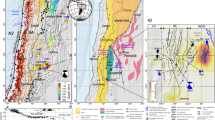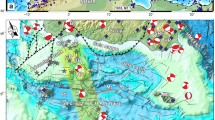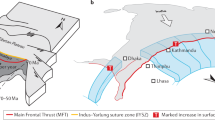Abstract
The Longmen Shan mountain range, site of the devastating 12 May 2008 Wenchuan (M = 7.9) earthquake, defines the eastern margin of the Himalayan orogen and exhibits greater topographic relief than anywhere else in the Tibetan plateau. However, before the earthquake, geodetic and geologic surveys measured little shortening across the range front1,2,3, inspiring a vigorous debate about the process by which the topography of the mountain belt is produced and maintained. Two endmember models have been proposed: (1) brittle crustal thickening, in which thrust faults with large amounts of slip that are rooted in the lithosphere cause uplift4, and (2) crustal flow, in which low-viscosity material in the lower crust extrudes outward from the Tibetan plateau and inflates the crust north and east of the Himalayas5,6,7. Here we use balanced geologic cross-sections to show that crustal shortening, structural relief, and topography are strongly correlated in the range front. This suggests that crustal shortening is a primary driver for uplift and topography of the Longmen Shan on the flanks of the plateau. The 2008 Wenchuan (M = 7.9) earthquake, which ruptured a large thrust fault along the range front causing tens of thousands of fatalities and widespread damage, is an active manifestation of this shortening process.
This is a preview of subscription content, access via your institution
Access options
Subscribe to this journal
Receive 51 print issues and online access
$199.00 per year
only $3.90 per issue
Buy this article
- Purchase on Springer Link
- Instant access to full article PDF
Prices may be subject to local taxes which are calculated during checkout




Similar content being viewed by others
References
Shen, Z. K., Lu, J. N., Wang, M. & Burgmann, R. Contemporary crustal deformation around the southeast borderland of the Tibetan Plateau. J. Geophys. Res. 110 11409 10.1029/2004JB003421 (2005)
Meade, B. J. Present-day kinematics at the India-Asia collision zone. Geology 35, 81–84 (2007)
Chen, Z. et al. Global Positioning System measurements from eastern Tibet and their implications for India/Eurasia intercontinental deformation. J. Geophys. Res. 105, 16215–16227 (2000)
Tapponnier, P. et al. Geology—Oblique stepwise rise and growth of the Tibet plateau. Science 294, 1671–1677 (2001)
Royden, L. H. et al. Surface deformation and lower crustal flow in eastern Tibet. Science 276, 788–790 (1997)
Burchfiel, B. C. 2003 presidential address: New technology, new geological challenges. GSA Today 14, 4–9 (2004)
Bird, P. Lateral extrusion of lower crust from under high topography, in the isostatic limit. J. Geophys. Res. 96, 10275–10286 (1991)
Yin, A. & Harrison, T. M. Geologic evolution of the Himalayan-Tibetan orogen. Annu. Rev. Earth Planet. Sci. 28, 211–280 (2000)
Rapine, R., Tilmann, F., West, M., Ni, J. & Rodgers, A. Crustal structure of northern and southern Tibet from surface wave dispersion analysis. J. Geophys. Res. 108 B22120 10.1029/2001JB000445 (2003)
Xu, L., Rondenay, S. & van der Hilst, R. D. Structure of the crust beneath the southeastern Tibetan Plateau from teleseismic receiver functions. Phys. Earth Planet. Inter. 165, 176–193 (2007)
Yao, H., Behein, C. & van der Hilst, R. D. Surface wave array tomography in SE Tibet from ambient seismic noise and two-station analysis. II. Crustal and upper-mantle structure. Geophys. J. Int. 173, 205–219 (2008)
Kirby, E. et al. Late Cenozoic evolution of the eastern margin of the Tibetan Plateau: Inferences from 40Ar/39Ar and (U-Th)/He thermochronology. Tectonics 21 (1). 1001 10.1029/2000TC001246 (2002)
Densmore, A. L. et al. Active tectonics of the Beichuan and Pengguan faults at the eastern margin of the Tibetan Plateau. Tectonics 26 TC4005 10.1029/2006TC001987 (2007)
Burchfiel, B. C. et al. A geological and geophysical context for the Wenchuan earthquake of 12 May 2008, Sichuan, People’s Republic of China. GSA Today 18, 4–11 (2008)
Burchfiel, B. C. et al. Tectonics of the Longmen Shan and adjacent regions, Central China. Int. Geol. Rev. 37, 661–735 (1995)
Clark, M. K., Bush, J. W. M. & Royden, L. H. Dynamic topography produced by lower crustal flow against rheological strength heterogeneities bordering the Tibetan Plateau. Geophys. J. Int. 162, 575–590 (2005)
Medvedev, S. & Beaumont, C. in Channel Flow, Ductile Extrusion and Exhumation in Continental Collision Zones (eds Law, R. D., Searle, M. P. & Godin, L.) 147–164 (Geological Society, London, 2006)
Shaw, J. H., Connors, C. & Suppe, J. Seismic Interpretation of Contractional Fault-related Folds: An AAPG Seismic Atlas 1-58 (AAPG, 2005)
Suppe, J. Geometry and kinematics of fault-bend folding. Am. J. Sci. 283, 684–721 (1983)
Chen, S. F. & Wilson, C. J. L. Emplacement of the Longmen Shan Thrust-Nappe Belt along the eastern margin of the Tibetan Plateau. J. Struct. Geol. 18, 413–430 (1996)
Acknowledgements
We thank the reviewers, E. Kirby and J. Dolan, for their comments and suggestions. Texaco and the China National Petroleum Corporation provided the seismic data used in this project.
Author information
Authors and Affiliations
Corresponding author
Supplementary information
Supplementary Figures
This file contains Supplementary Figures 1-2 with Legends (PDF 3421 kb)
Rights and permissions
About this article
Cite this article
Hubbard, J., Shaw, J. Uplift of the Longmen Shan and Tibetan plateau, and the 2008 Wenchuan (M = 7.9) earthquake. Nature 458, 194–197 (2009). https://doi.org/10.1038/nature07837
Received:
Accepted:
Issue Date:
DOI: https://doi.org/10.1038/nature07837
This article is cited by
-
Dynamic response and failure process of horizontal-layered fractured structure rock slope under strong earthquake
Journal of Mountain Science (2024)
-
Formation of the Tibetan Plateau during the India-Eurasia Convergence: Insight from 3-D Multi-Terrane Thermomechanical Modeling
Journal of Earth Science (2024)
-
Reconciling patterns of long-term topographic growth with coseismic uplift by synchronous duplex thrusting
Nature Communications (2023)
-
Interaction of earthquake-triggered landslides and local relief: Evidence from the 2008 Wenchuan earthquake
Landslides (2023)
-
Engineering behavior of soft rock tunnels in mountainous areas under multiple hazard inducers: a case study of the Jiuzhaigou-Mianyang Expressway
Bulletin of Engineering Geology and the Environment (2022)
Comments
By submitting a comment you agree to abide by our Terms and Community Guidelines. If you find something abusive or that does not comply with our terms or guidelines please flag it as inappropriate.



